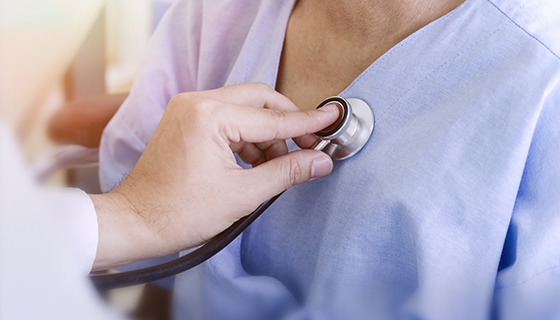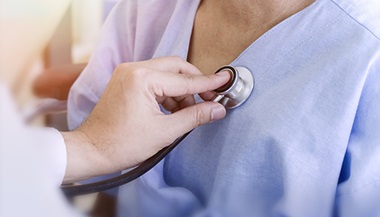Heart Valve Diseases
What are heart valves?
The heart consists of 4 chambers--2 atria (upper chambers) and 2 ventricles (lower chambers). Blood passes through a valve as it leaves each chamber of the heart. The valves prevent the backward flow of blood. They act as one-way inlets of blood on one side of a ventricle and one-way outlets of blood on the other side of a ventricle. The 4 heart valves include the following:
-
Tricuspid valve. Located between the right atrium and the right ventricle.
-
Pulmonary valve. Located between the right ventricle and the pulmonary artery.
-
Mitral valve. Located between the left atrium and the left ventricle.
-
Aortic valve. Located between the left ventricle and the aorta.
How do the heart valves function?
As the heart muscle contracts and relaxes, the valves open and close, letting blood flow into the ventricles and out to the body at alternate times. The following is a step-by-step explanation of blood flow through the heart.
-
The left and right atrium contract once they are filled with blood. This pushes open the mitral and tricuspid valves. Blood is then pumped into the ventricles.
-
The left and right ventricles contact. This closes the mitral and tricuspid valves preventing back blood flow. At the same time, the aortic and pulmonic valves open to let blood be pumped out of the heart.
-
The left and right ventricles relax. The aortic and pulmonic valves close preventing backward blood flow into the heart. The mitral and tricuspid valves then open to allow forward blood flow within the heart to fill the ventricles again.
What is heart valve disease?
Heart valve disorders can arise from 2 main types of problems:
-
Regurgitation (or leakage of the valve). When the valve(s) do not close completely, it causes blood to flow backward through the valve. This reduces forward blood flow and can lead to volume overload in the heart.
-
Stenosis (or narrowing of the valve). When the valve(s) opening becomes narrowed, it limits the flow of blood out of the ventricles or atria. The heart is forced to pump blood with increased force to move blood through the narrowed or stiff (stenotic) valve(s).
Heart valves can develop both regurgitation and stenosis at the same time. Also, more than one heart valve can be affected at the same time. When heart valves fail to open and close properly, the effects on the heart can be serious, possibly hampering the heart's ability to pump enough blood through the body. Heart valve problems are one cause of heart failure.
What are the symptoms of heart valve disease?
Mild to moderate heart valve disease may not cause any symptoms. These are the most common symptoms of heart valve disease:
-
Chest pain
-
Palpitations caused by irregular heartbeats
-
Fatigue
-
Dizziness
-
Low or high blood pressure, depending on which valve disease is present
-
Shortness of breath
-
Abdominal pain due to an enlarged liver (if there is tricuspid valve malfunction)
-
Leg swelling
Symptoms of heart valve disease may look like other medical problems. Always see your doctor for a diagnosis.
What causes heart valve damage?
The causes of heart valve damage vary depending on the type of disease present, and may include the following:
-
Changes in the heart valve structure due to aging
-
Coronary artery disease and heart attack
-
Heart valve infection
-
Birth defect
-
Syphilis (a sexually-transmitted infection)
-
Myxomatous degeneration (an inherited connective tissue disorder that weakens the heart valve tissue)
The mitral and aortic valves are most often affected by heart valve disease. Some of the more common heart valve diseases include:
|
Heart valve disease |
Symptoms and causes |
|---|---|
|
Bicuspid aortic valve |
With this birth defect, the aortic valve has only 2 leaflets instead of 3. If the valve becomes narrowed, it is harder for the blood to flow through, and often the blood leaks backward. Symptoms usually don't until the adult years. |
|
Mitral valve prolapse (also known as click-murmur syndrome, Barlow's syndrome, balloon mitral valve, or floppy valve syndrome) |
With this defect, the mitral valve leaflets bulge and don't close properly during the contraction of the heart. This lets blood to leak backward. This may result in a mitral regurgitation murmur. |
|
Mitral valve stenosis |
With this valve disease, the mitral valve opening is narrowed. It is often caused by a past history of rheumatic fever. It increases resistance to blood flow from the left atrium to the left ventricle. |
|
Aortic valve stenosis |
This valve disease occurs mainly in the elderly. It causes the aortic valve opening to narrow. This increases resistance to blood flow from the left ventricle to the aorta. |
|
Pulmonary stenosis |
With this valve disease, the pulmonary valve does not open sufficiently. This forces the right ventricle to pump harder and enlarge. This is usually a congenital condition. |
How is heart valve disease diagnosed?
Your doctor may think you have heart valve disease if your heart sounds heard through a stethoscope are abnormal. This is usually the first step in diagnosing a heart valve disease. A characteristic heart murmur (abnormal sounds in the heart due to turbulent blood flow across the valve) can often mean valve regurgitation or stenosis. To further define the type of valve disease and extent of the valve damage, doctors may use any of the following tests:
-
Electrocardiogram (ECG). A test that records the electrical activity of the heart, shows abnormal rhythms (arrhythmias), and can sometimes detect heart muscle damage.
-
Echocardiogram (echo). This noninvasive test uses sound waves to evaluate the heart's chambers and valves. The echo sound waves create an image on a monitor as an ultrasound transducer is passed over the heart. This is the best test to evaluate heart valve function.
-
Transesophageal echocardiogram (TEE).This test involves passing a small ultrasound transducer down into the esophagus. The sound waves create an image of the valves and chambers of the heart on a computer monitor without the ribs or lungs getting in the way.
-
Chest X-ray. This test that uses invisible electromagnetic energy beams to produce images of internal tissues, bones, and organs onto film. An X-ray can show enlargement in any area of the heart.
-
Cardiac catheterization. This test involves the insertion of a tiny, hollow tube (catheter) through a large artery in the leg or arm leading to the heart to provide images of the heart and blood vessels. This procedure is helpful in determining the type and extent of certain valve disorders.
-
Magnetic resonance imaging (MRI). This test uses a combination of large magnets, radiofrequencies, and a computer to produce detailed images of organs and structures within the body.
What is the treatment for heart valve disease?
In some cases, your doctor may just want to closely watch the heart valve problem for a period. However, other options include medicine, or surgery to repair or replace the valve. Treatment varies, depending on the type of heart valve disease, and may include:
-
Medicine. Medicines are not a cure for heart valve disease, but treatment can often relieve symptoms. These medicines may include:
-
Beta-blockers, digoxin, and calcium channel blockers to reduce symptoms of heart valve disease by controlling the heart rate and helping to prevent abnormal heart rhythms.
-
Medications to control blood pressure, such as diuretics (remove excess water from the body by increasing urine output) or vasodilators (relax the blood vessels, decreasing the force against which the heart must pump) to ease the work of the heart.
-
-
Surgery. Surgery may be needed to repair or replace the malfunctioning valve(s). Surgery may include:
-
Heart valve repair. In some cases, surgery on the malfunctioning valve can help ease symptoms. Examples of heart valve repair surgery include remodeling abnormal valve tissue so that the valve works properly, or inserting prosthetic rings to help narrow a dilated valve. In many cases, heart valve repair is preferable, because a person's own tissues are used.
-
Heart valve replacement. When heart valves are severely malformed or destroyed, they may need to be replaced with a new valve. Replacement valves may be either tissue (biologic) valves, which include animal valves and donated human aortic valves, or mechanical valves, which can consist of metal, plastic, or another artificial material. This usually requires heart surgery. But, certain valve diseases such as aortic valve stenosis or mitral valve regurgitation may be managed using non- surgical methods.
-
Another treatment option that is less invasive than valve repair or replacement surgery is balloon valvuloplasty. This is a non-surgical procedure in which a special catheter (hollow tube) is threaded into a blood vessel in the groin and guided into the heart. At the tip of the catheter is a deflated balloon that is inserted into the narrowed heart valve. Once in place, the balloon is inflated to stretch the valve open, and then removed. This procedure is sometimes used to treat pulmonary stenosis and, in some cases, aortic stenosis.






